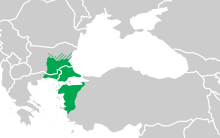Schmidtler's smooth newt
| Schmidtler's smooth newt | |
|---|---|

| |
| Male during breeding season[1] | |
| Scientific classification | |
| Domain: | Eukaryota |
| Kingdom: | Animalia |
| Phylum: | Chordata |
| Class: | Amphibia |
| Order: | Urodela |
| Family: | Salamandridae |
| Genus: | Lissotriton |
| Species: | L. schmidtleri
|
| Binomial name | |
| Lissotriton schmidtleri | |

| |
| range in the Balkans and in Anatolia; hatching indicates unclear contact zones with L. vulgaris
| |
| Synonyms[3] | |
| |
Schmidtler's smooth newt (Lissotriton schmidtleri) is a
Christopher Raxworthy described the species in 1988 as Triturus vulgaris schmidtleri, a subspecies of the smooth newt.[2] After genetic data had suggested the smooth newt was a complex of distinct lineages, Pabijan and colleagues recognised Schmidtler's smooth newt as distinct species in 2017.[6] This was followed by subsequent authors.[3][4]
The species differs from other species in the smooth newt species complex mainly in the male secondary characters during breeding season.[4] It is overall very similar to the smooth newt but rather small, with males reaching 5–7 cm (2.0–2.8 in) length. The dorsal crest reaches 2 mm or more in height and is denticulated. The tail end is elongated but does not have a filament as in the neighbouring Kosswig's smooth newt. The body is slightly square-shaped but has no dorso-lateral folds. Toe flaps are only weakly developed.[2][5]: 234
The species's
References
- ^ PMID 25829839.
- ^ ISSN 0952-8369.
- ^ doi:10.5531/db.vz.0001. Archived from the originalon 25 April 2020. Retrieved 25 April 2020.
- ^ S2CID 4941926. Archived from the original(PDF) on 28 April 2019.
- ^ ISBN 9789004285620.
- PMID 28797693.
- doi:10.30906/1026-2296-2016-23-2-158-162 (inactive 31 January 2024).)
{{cite journal}}: CS1 maint: DOI inactive as of January 2024 (link
